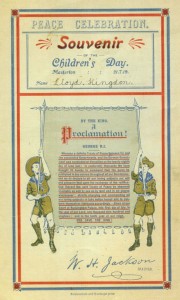Peace Celebrations – A Part of the WW1 Story
 Ministry for Culture and Heritage
Ministry for Culture and Heritage
Media release
A neglected part of New Zealand’s First World War story, the elaborate peace celebrations held in July 1919, is now being told on Ministry for Culture and Heritage website www.nzhistory.net.nz.
‘In July 1919 communities across New Zealand held three days of celebrations to mark the signing of peace between the Allies and Germany. Enthusiastic celebrations had been held following the armistice in November 1918. But they were spontaneous and inevitably somewhat rambling affairs. Some had also been marred by the outbreak of the influenza pandemic. Many saw the official end to the war as another opportunity to stage celebrations, in a manner more befitting the sacrifices made’ said Ministry for Culture and Heritage historian Imelda Bargas.
‘Images of the 1919 peace celebrations have sometimes been misidentified as dating from the signing of the armistice in 1918. This entry sets the record straight about the differences between the two events. It points out that New Zealanders were so happy about the end of the war that they celebrated it twice!’
‘Countries throughout the British Empire held similar celebrations. But New Zealand was somewhat unusual with its three, or more, days of events. New Zealand’s plans were already well advanced by the time the British government advised that it would be holding a day of thanksgiving on 6th of July and a peace celebration day on the 19th. So though the country celebrated with the Empire on these days, it also went ahead with further events on the 20th and 21st’.
‘A coal shortage meant it was not viable to transport large numbers of people to central locations. Celebrations were instead held everywhere from the main centres and their surrounding suburbs, to small towns and rural areas’.
‘Most communities followed the format suggested by the government which called for a soldiers’ day, a day of thanksgiving and a children’s day. Soldiers’ day generally involved a parade in the morning, sporting activities in the afternoon, and bonfires and fireworks in the evening. The day of thanksgiving commonly involved special services at all churches, but many also held large combined services. Children’s day probably had the widest variety of events. Some activities had educational purposes, like the singing of patriotic songs; others were pure entertainment, like picture shows’.
The feature is available at the following link: http://www.nzhistory.net.nz/war/1919-peace-celebrations
a WordPress rating system
a WordPress rating system



Voices of our community